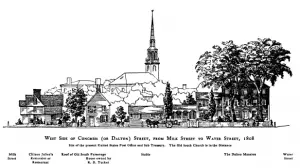In November of 1773, the artist John Singleton Copley visited the Old South Meeting House to negotiate with the Sons of Liberty. He was between a rock and a hard place. He was well known among the patriot agitators of the Massachusetts colony, having painted portraits of leaders such as Samuel Adams and John Hancock.
His family and his own leanings were Loyalist, however, and his father-in-law Richard Clarke had just been consigned a load of tea,. At that moment the tea sat in the hold of a ship in Boston Harbor.
Old South Meeting House
The famous standoff that would lead to the Boston Tea Party had begun. Clarke belonged to a group of Loyalist merchants allocated part of the tea shipment from the East India Company. He already faced pressure to resign his position as agent for the company.
Massachusetts patriots, led by John Hancock and Sam Adams, were determined that the ship would not land. They must send it home. If Clarke tried to unload the tea, the patriots would almost certainly attack him. If he sent it back to England, he would almost certainly be ruined financially as well as politically.
With the patriots meeting at the Old South Meeting House to discuss what to do about the tea on November 30, Copley joined the meeting to plead Clarke’s case. Clarke did not dislike or fear the patriots or their cause, Copley explained. But he did not attend the meeting because he didn’t want to create more controversy than already existed.
He knew the patriots wanted to send the ships away still carrying their tea. Clarke, Copley said, simply couldn’t do that. In a letter to his brothers-in-law Jonathan and Isaac Clarke, he explained how the tense standoff had proceeded.
I . . . observed you had shown no disposition to bring the teas into the town, nor would you; But only must be excused from being the active instruments in sending it back…that you did not bring yourselves into this difficulty and therefore, ought not to be pressed to do an act that would involve you in Ruin.
Nonstarter at Old South
Instead of agreeing to reject the tea outright, Copley carried a proposal from the men who had received it. They would unload it and store it on the wharf uninspected while the patriots pressed their case with the king and colonial governor.
The idea was a nonstarter. Letting the tea off the ship, the patriots concluded, would have meant accepting it in the country. That meant a tax. The tea would never land in America, they told Copley.
Copley regarded the meeting as partially successful, however, since the attitudes toward the Clarkes personally had softened somewhat, and some had defended them, he said, arguing that it was not fair to insist that the family ruin itself over this issue.
“It cooled the resentment and they dissolved without doing or saying anything that showed an ill temper toward you,” he wrote. “I think all stands well at present.”
Nothing was further from the truth, of course, the royal governor insisted the tea must be unloaded and the patriot meetings be banned.
Within two years, Copley and the Clarkes had fled to England. The much-debated tea, of course, had long sunk to the bottom of Boston Harbor.
This story last updated in 2022.



3 comments
I knew about Copley’s Tory background but did not know about his going to the Old South for the meeting – incredibly interesting…
[…] contemporaries like John Singleton Copley of Boston, Phillips worked on the sparsely populated frontier, where he had to roam the […]
[…] John Singleton Copley, the artist who painted so many of the important people of the late 18th century, tried to work out a compromise with the Sons of Liberty. His father-in-law was an East India merchant who needed the tea. At the Old South Meetinghouse on Nov. 30, 1773, Copley argued the tea should be unloaded and kept in a warehouse while the colonists pressed their case with the governor and the Crown. He didn’t win his argument. […]
Comments are closed.